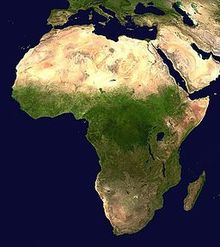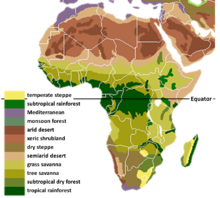Geography
Main article: Geography of Africa
Africa is the largest of the three great southward projections from the largest landmass of the Earth. Separated from Europe by the Mediterranean Sea, it is joined to Asia at its northeast extremity by the Isthmus of Suez (transected by the Suez Canal), 163 km (101 mi) wide.[53] (Geopolitically, Egypt's Sinai Peninsula east of the Suez Canal is often considered part of Africa, as well.)[54]
From the most northerly point, Ras ben Sakka in Tunisia(37°21' N), to the most southerly point, Cape Agulhas in South Africa (34°51'15" S), is a distance of approximately 8,000 km (5,000 mi);[55] from Cape Verde, 17°33'22" W, the westernmost point, to Ras Hafun in Somalia, 51°27'52" E, the most easterly projection, is a distance of approximately 7,400 km (4,600 mi).[56] The coastline is 26,000 km (16,000 mi) long, and the absence of deep indentations of the shore is illustrated by the fact that Europe, which covers only 10,400,000 km2 (4,000,000 sq mi) – about a third of the surface of Africa – has a coastline of 32,000 km (20,000 mi).[56]
Africa's largest country is Algeria, and its smallest country is the Seychelles, an archipelago off the east coast.[57] The smallest nation on the continental mainland is the Gambia.
Geologically, Africa includes the Arabian Peninsula; the Zagros Mountains of Iran and the Anatolian Plateau of Turkey mark where the African Plate collided with Eurasia. TheAfrotropic ecozone and the Saharo-Arabian desert to its north unite the region biogeographically, and the Afro-Asiatic language family unites the north linguistically.
Climate
Main article: Climate of Africa
The climate of Africa ranges from tropical to subarctic on its highest peaks. Its northern half is primarily desert or arid, while its central and southern areas contain both savanna plains and very dense jungle (rainforest) regions. In between, there is a convergence where vegetation patterns such as sahel, and steppe dominate. Africa is the hottest continent on earth; drylands and deserts comprise 60% of the entire land surface.[58] The record for the highest temperature recorded was set in Libya in 1922 (58 °C (136 °F)).[59]
Fauna
Main article: Fauna of Africa
Africa boasts perhaps the world's largest combination of density and "range of freedom" ofwild animal populations and diversity, with wild populations of large carnivores (such as lions,hyenas, and cheetahs) and herbivores (such as buffalo, elephants, camels, and giraffes) ranging freely on primarily open non-private plains. It is also home to a variety of "jungle" animals including snakes and primates and aquatic life such as crocodiles andamphibians. In addition, Africa has the largest number of megafauna species, as it was least affected by the extinction of the Pleistocene megafauna.
Ecology
Deforestation is affecting Africa at twice the world rate, according to the United Nations Environment Programme (UNEP).[60]According to the University of Pennsylvania African Studies Center, 31% of Africa's pasture lands and 19% of its forests and woodlands are classified as degraded, and Africa is losing over four million hectares of forest every year, which is twice the average deforestation rate compared to the rest of the world.[58] Some sources claim that deforestation has already destroyed roughly 90% of the original, virgin forests in West Africa.[61] Since the arrival of humans 2000 years ago, Madagascar has lost more than 90% of its original forest.[62] About 65% of Africa's agricultural land suffers from soil degradation.







No comments:
Post a Comment